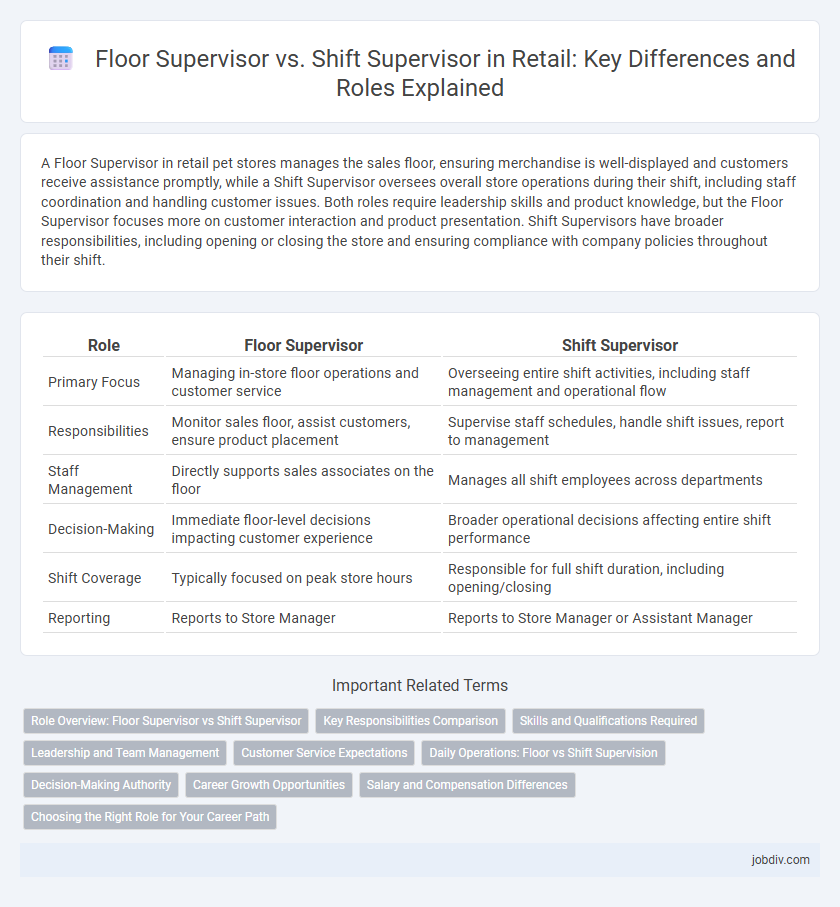A Floor Supervisor in retail pet stores manages the sales floor, ensuring merchandise is well-displayed and customers receive assistance promptly, while a Shift Supervisor oversees overall store operations during their shift, including staff coordination and handling customer issues. Both roles require leadership skills and product knowledge, but the Floor Supervisor focuses more on customer interaction and product presentation. Shift Supervisors have broader responsibilities, including opening or closing the store and ensuring compliance with company policies throughout their shift.
Table of Comparison
| Role | Floor Supervisor | Shift Supervisor |
|---|---|---|
| Primary Focus | Managing in-store floor operations and customer service | Overseeing entire shift activities, including staff management and operational flow |
| Responsibilities | Monitor sales floor, assist customers, ensure product placement | Supervise staff schedules, handle shift issues, report to management |
| Staff Management | Directly supports sales associates on the floor | Manages all shift employees across departments |
| Decision-Making | Immediate floor-level decisions impacting customer experience | Broader operational decisions affecting entire shift performance |
| Shift Coverage | Typically focused on peak store hours | Responsible for full shift duration, including opening/closing |
| Reporting | Reports to Store Manager | Reports to Store Manager or Assistant Manager |
Role Overview: Floor Supervisor vs Shift Supervisor
A Floor Supervisor in retail manages the sales floor operations, ensuring product displays are attractive and customer service standards are met, focusing on employee guidance during store hours. A Shift Supervisor oversees entire store activities during a specific shift, including staff coordination, opening or closing procedures, and resolving operational issues. Both roles require leadership and communication skills but differ in scope, with Floor Supervisors concentrating on customer-facing areas and Shift Supervisors handling broader store management tasks.
Key Responsibilities Comparison
A Floor Supervisor oversees daily operations on the sales floor, ensuring customer satisfaction, managing staff performance, and maintaining merchandise presentation to drive sales. A Shift Supervisor focuses on coordinating shift schedules, monitoring employee attendance, handling operational issues, and enforcing company policies during their specific shift. Both roles involve leadership and team management, but the Floor Supervisor emphasizes customer interaction and sales floor efficiency, while the Shift Supervisor prioritizes shift operations and employee oversight.
Skills and Qualifications Required
Floor Supervisors require strong customer service skills, team leadership, and expertise in inventory management to efficiently oversee retail operations on the sales floor. Shift Supervisors must possess excellent time management, conflict resolution abilities, and a thorough understanding of store policies to manage staff during their shifts and ensure smooth workflow. Both roles demand effective communication, problem-solving skills, and prior retail experience to maintain high productivity and customer satisfaction.
Leadership and Team Management
Floor Supervisors oversee daily retail operations, ensuring team alignment with sales targets and customer service standards through direct leadership on the sales floor. Shift Supervisors manage workforce scheduling, delegate tasks, and maintain operational efficiency while addressing employee concerns during their shifts. Both roles require strong leadership skills, but Floor Supervisors emphasize frontline team motivation and customer interaction, whereas Shift Supervisors focus on shift coordination and performance monitoring.
Customer Service Expectations
Floor Supervisors prioritize direct interaction with customers to resolve issues promptly and ensure a seamless shopping experience, emphasizing personalized assistance and product knowledge. Shift Supervisors manage overall team performance and operational efficiency during their shifts, ensuring staff adhere to customer service standards and handle escalations effectively. Both roles are essential in maintaining high customer satisfaction but differ in focus, with Floor Supervisors being more hands-on on the sales floor and Shift Supervisors overseeing broader shift operations.
Daily Operations: Floor vs Shift Supervision
Floor supervisors manage daily customer interactions and oversee merchandise presentation to ensure seamless in-store experiences. Shift supervisors coordinate employee schedules, monitor overall store performance, and address operational issues during specific shifts. Both roles require strong leadership but differ in focus, with floor supervisors emphasizing frontline engagement and shift supervisors prioritizing shift-wide efficiency and staff coordination.
Decision-Making Authority
Floor Supervisors primarily manage staff and customer interactions on the sales floor, making operational decisions related to merchandising and customer service. Shift Supervisors hold broader decision-making authority, overseeing entire shift operations, including staff scheduling, conflict resolution, and inventory control. The shift supervisor's role involves higher-level strategic decisions impacting overall store performance during their shift.
Career Growth Opportunities
Floor Supervisors often gain hands-on experience managing daily operations and direct team interactions, which enhances their leadership skills foundational for advancement. Shift Supervisors typically oversee broader responsibilities, including staff scheduling and performance management, positioning them for higher managerial roles. Transitioning from Floor to Shift Supervisor expands career growth opportunities by developing strategic decision-making and operational oversight expertise essential for retail management progression.
Salary and Compensation Differences
Floor Supervisors in retail typically earn an average salary ranging from $30,000 to $45,000 annually, reflecting their direct oversight of daily store operations and staff coordination. Shift Supervisors often receive slightly higher compensation, averaging $35,000 to $50,000 per year, due to their responsibility for managing entire shifts, including opening and closing stores and handling more complex operational tasks. Variations in salary between these roles depend on store size, location, and the extent of managerial duties, with shift supervisors generally commanding higher pay due to increased responsibility.
Choosing the Right Role for Your Career Path
Floor Supervisors primarily focus on managing daily store operations, ensuring customer satisfaction, and overseeing sales associates on the retail floor. Shift Supervisors take on broader responsibilities, including monitoring employee performance, handling shift schedules, and addressing operational challenges during their shifts. Selecting the right role depends on your career goals: choose Floor Supervisor for hands-on customer interaction and team leadership, or Shift Supervisor for strategic management experience and advancing into senior management positions.
Floor Supervisor vs Shift Supervisor Infographic

 jobdiv.com
jobdiv.com